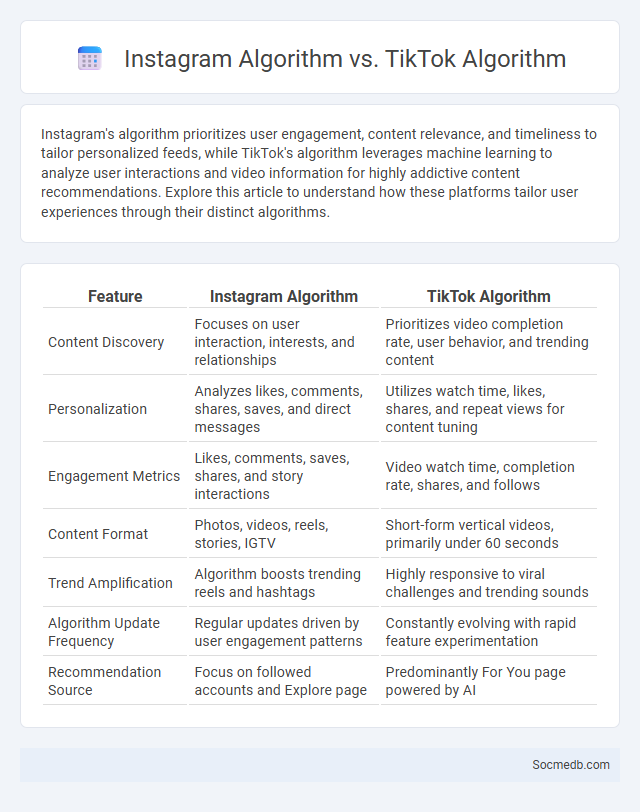
Photo illustration: Instagram Algorithm vs TikTok Algorithm
Instagram's algorithm prioritizes user engagement, content relevance, and timeliness to tailor personalized feeds, while TikTok's algorithm leverages machine learning to analyze user interactions and video information for highly addictive content recommendations. Explore this article to understand how these platforms tailor user experiences through their distinct algorithms.
Table of Comparison
| Feature | Instagram Algorithm | TikTok Algorithm |
|---|---|---|
| Content Discovery | Focuses on user interaction, interests, and relationships | Prioritizes video completion rate, user behavior, and trending content |
| Personalization | Analyzes likes, comments, shares, saves, and direct messages | Utilizes watch time, likes, shares, and repeat views for content tuning |
| Engagement Metrics | Likes, comments, saves, shares, and story interactions | Video watch time, completion rate, shares, and follows |
| Content Format | Photos, videos, reels, stories, IGTV | Short-form vertical videos, primarily under 60 seconds |
| Trend Amplification | Algorithm boosts trending reels and hashtags | Highly responsive to viral challenges and trending sounds |
| Algorithm Update Frequency | Regular updates driven by user engagement patterns | Constantly evolving with rapid feature experimentation |
| Recommendation Source | Focus on followed accounts and Explore page | Predominantly For You page powered by AI |
Understanding the Instagram Algorithm
The Instagram algorithm prioritizes content based on user engagement, relevance, and timeliness, analyzing likes, comments, shares, and saves to tailor your feed. It leverages machine learning to predict which posts you are most likely to interact with, thereby maximizing your content visibility. Understanding these factors can help you optimize posts and increase your reach effectively.
Decoding the TikTok Algorithm
TikTok's algorithm prioritizes content based on user interactions, video information, and device settings to deliver highly personalized feeds. It analyzes your likes, shares, comments, and watch time to predict and surface videos you are most likely to enjoy. Understanding these factors helps you optimize your content strategy for better visibility and engagement.
How Each Platform Prioritizes Content
Social media platforms prioritize content based on user engagement metrics, such as likes, shares, comments, and time spent on posts, to optimize your feed for relevancy and interaction. Algorithms on Instagram emphasize visual appeal and recency, while Facebook focuses on meaningful conversations and personal connections, and TikTok prioritizes short, engaging videos with trending audio. Understanding these priorities helps you tailor content effectively for maximum visibility and impact on each platform.
Engagement Metrics: Instagram vs TikTok
Instagram engagement metrics highlight average like rates of 4.7% and comment rates near 0.5%, with Stories boasting a completion rate around 70%. TikTok outperforms with an average engagement rate of 5.3%, driven by video views, shares, and follower growth, exhibiting average watch times over 52 seconds. Analyzing these key metrics reveals TikTok's higher user interaction, while Instagram remains strong for brand affinity and story-driven engagement.
Content Discovery: Explore Page vs For You Page
The Explore Page on social media platforms curates trending and popular content based on general user interests and global engagement patterns, helping you discover new topics and creators beyond your current network. The For You Page, specifically tailored by algorithms analyzing your past interactions, preferences, and behavior, presents personalized content designed to match your unique tastes and keep you engaged longer. Understanding the difference between Explore and For You Pages allows you to strategically expand your content exposure while enjoying a customized browsing experience.
Impact of Algorithms on Influencer Reach
Social media algorithms heavily influence influencer reach by prioritizing content based on user engagement, relevance, and personalized interests, often limiting visibility to specific audience segments. These algorithms analyze behavioral data to amplify posts from influencers who consistently drive high interaction rates, making algorithm mastery essential for expanding Your brand presence. Understanding and adapting to these algorithmic changes can significantly enhance Your ability to maintain and grow follower engagement across platforms.
Influencer Strategies: Instagram vs TikTok
Instagram influencer strategies emphasize curated content, leveraging Stories and Reels to engage followers through polished visuals and interactive polls, driving brand collaborations. TikTok focuses on authentic, short-form videos using trends, challenges, and viral sounds to increase reach and foster community engagement quickly. Data shows TikTok's algorithm promotes rapid follower growth, while Instagram relies on established follower bases for sustained influencer impact.
Algorithm Updates and Their Effects on Influencers
Algorithm updates on platforms like Instagram and TikTok significantly impact influencer visibility by altering content distribution and engagement metrics. You must adapt your content strategy to align with new ranking factors, such as favoring video content or prioritizing authentic interactions, to maintain follower growth and reach. Understanding these changes enables influencers to optimize posts, ensuring sustained relevance and potential for brand collaborations.
Case Studies: Influencer Success Across Platforms
Case studies reveal how influencer marketing drives engagement and brand loyalty across platforms such as Instagram, TikTok, and YouTube by leveraging authentic storytelling and niche targeting. Brands that collaborate with micro-influencers see higher conversion rates due to their dedicated and highly engaged audiences. Your social media strategy can benefit from analyzing these successes to tailor campaigns that maximize reach and ROI.
Choosing the Right Platform for Maximum Influence
Selecting the right social media platform depends on your target audience's demographics and behavior, ensuring content reaches those most likely to engage. Platforms like Instagram and TikTok excel in visual storytelling for younger users, while LinkedIn targets professionals and B2B marketing effectively. Analyzing platform-specific analytics helps optimize content strategy and maximize influence across varied social channels.
 socmedb.com
socmedb.com